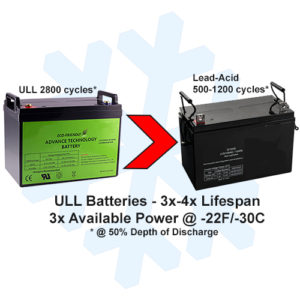The Charging Parameters for Lead Crystal/SiO2/Silicon Dioxide Batteries are a bit different than regular lead acid batteries. To Optimize your charge efficiency, if you can, it is better to manually set the charging references.
The State of Charge chart is for zero or minimal load on the batteries, if there is a load on the batteries, then the voltages would be lower.
State of Charge Parameter for EFSN SiO2 Batteries
State of Charge Parameter for EFSL SiO2 Batteries
Bulk/Absorption Charging voltage range is 14.4V – 14.7V, with 14.6V optimal.
Float Charging voltage 13.5V – 13.8V.
For SiO2 Batteries, the Maximum/Optimal Charging Current is 25% of Ah capacity. This can be expressed as a 0.25C, C/4, or 4-hour Charge Rate.
Charging at lower current is fine, but these batteries actually charge more efficiently at the maximum rate. This also minimizes run time for a generator, and reduces fuel use, and reduces RV and boat docking time for shore power AC charging.
When the battery is fully charged, there is often an initial “surface charge” voltage normally starting at around 13.5V with no load, and will stabilize at around 13.05V after 4-6hrs. Or you can run a small load on the battery for a brief period to dissipate the surface charge for a more accurate voltmeter reading. This is common with most lead-acid batteries as well.
This should help you fine-tune your charging and monitoring systems to get the most out of your silicon dioxide/SiO2 battery.
Please feel free to contact us with any questions!

